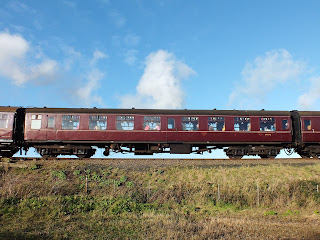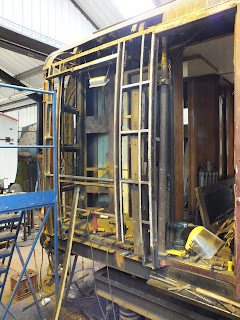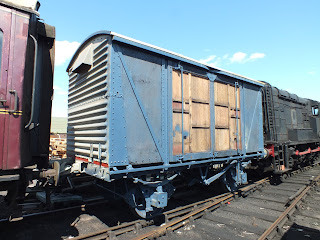This week we celebrate the return to service of M4843 after a two year "Silver" standard overhaul. M4843 is one of a collection of eight British Railways Mark 1 "Tourist Second Open" coaches owned by the North Norfolk Railway, which form the backbone of our two daily running sets which are essential for the railway's operations and survival. It is therefore important, in our view, that these are overhauled to a high standard so that we can continue to use them for years to come.
The year of M4843's birth is contested. Some literature states it was built in 1959 and the coach has a plate on it suggesting this, however other records show it was not introduced into service until the following year. Either it was built in 1959 and stored for a period before entering service, or if it was built in 1960. In any case, by July 1960 M4843 was part of the London Midland fleet of Mark 1 coaches, some ten years after the first example had been introduced. M4843 was part of a batch of 61 Tourist Second Opens built at Wolverton. Weighing 33 tons, M4843 seats 64 passengers in three saloons, one of which was designated no smoking. A central passenger gangway runs lengthways throughout the open layout saloons, with corridor connections at both ends for access to adjacent vehicles. Two toilets were present at one end of the coach, although these are now longer in use and have been converted by the NNR into store cupboards. Another conversion which was done in British Railways days was the swapping of the original bogies for more advanced "B4" versions, which saved a ton of the vehicle's weight.
Delivered in British Railway's lined maroon livery in July 1960, M4843 led an uneventful life working medium and long distance locomotive hauled services all over the Midland Region and through to neighboring regions as services required. With the modernisation program in full swing when M4843 was built, it would only have seen a few years being hauled by steam locomotives before diesels took over. To meet BR's new image, M4843 was repainted into the corporate Blue & Grey colour scheme, most likely in the late 1960's. Electric heating was also added to the original steam heating making the coach duel fitted, although the increasingly common air braking system was never fitted, M4843 remaining a vacuum only braked coach its entire life. In June 1982, 4843 was transferred to the Western Region for the remaining 8 years of its working life before being withdrawn from service in August 1990.
W4843 languished for a year in storage as was being held at Neville Hill near Leeds. By this time it had suffered somewhat with most of its window glass missing and considerable damage to the interior passenger saloons including smashed Formica wall paneling and smoke damaged vanished woodwork. Nevertheless it was purchased by the North Norfolk Railway. 25 of the 61 vehicles built in this batch were preserved, their later build date and their superior bogies had led to many of the batch not being withdrawn from service until the 1990's, making them more available to preservationists than many earlier batches. Considerable acquisitions of spare parts from other withdrawn Mark 1's at the time (ironically in much better condition than W4843 but being scrapped by BR) would mean W4843's return to service in preservation could be viable for a less-than-cash-rich NNR.
W4843 arrived by road to Sheringham on the 19th November 1991 - the current Blog writer was 13 days old! W4843's condition meant a quick dust over and entry into service was never an option, so a six year restoration was undertaken to improve W4843's condition. Exterior corrosion repairs were undertaken along with re-glazing and a full repaint back into original lined maroon. The interior was modified with the smashed Formica paneling replaced with varnished wooden panels, more authentic for earlier Mark 1 coaches, and the smoke damaged woodwork either repainted or replaced entirely.
Early 1997 saw E4843 (renumbered during its overhaul as an Eastern Region coach) launched into preservation service, in excellent order for the first time in many years. It subsequently became a "favorite" coach and operated high mileages for nearly ten years before having an intermediate attention and a repaint in 2006.
By this time the bodywork was beginning to suffer as a result of historic BR water ingress compounded with the further NNR use. Unfortunately due to some over zealous welding in the past, severe distortion of the lower panelwork had to be smoothed over by large amounts of bodyfiller to achieve a smooth surface. This necessity was to prove problematic in the future.
E4843 was returned to service and undertook a second decade of NNR use very successfully, remaining an operating department "favorite".
By summer 2017 further weathering had taken its toll and the previous large areas of filler were falling out making the coach visually unsightly. It was withdrawn from service and brought into works for a Silver overhaul.
The 6-12 month project soon spiraled upwards with extreme levels of corrosion being found at both ends of the vehicle and all around the toilet. Unfortunately the roof had failed in the corners, which whilst not being uncommon for Mark 1 vehicles, normally results in water heading directly downwards and rotting out the ends of the coach. On E4843, it had tracked horizontally behind the vehicle's gutter, rotting out a 12 foot section all around where the toilets were formerly situated, as well as the end itself. As a result, the vehicle was in the welding bay for over a year having these repairs attended to.
The worst 1/4 of the coach was also re-skinned from the windows downwards eliminating the worst section of historic distortion and excessive filler.
The rest of the coach was re-filled where required to achieve the usual smooth finish and other issues such as doorway repairs attended to before the exterior was ready for repainting.
In a testament to the original 1990's restoration, the interior was in much better condition and required only a deep rub down of the varnish woodwork and several coats of varnish applied to bring back the shine to the interior. Other small repairs were undertaken here and there and anything with a painted finish repainted leading to a very presentable result. The 1/4 re-skin already mentioned also required a fair level of interior dismantling and reassembly to give the access required for the repairs.
During the overhaul of the vehicle, as part of our recent policy to apply the regional number that the coach was first built for, we have returned M4843 to its Midland ancestry for the first time since 1982. It entered service earlier this week, resplendent in its maroon colours, so look out for it!
Great Eastern Railway 1899 4 Wheel Brake Third 853
Elsewhere in the workshops, the second coat of Crimson has now been applied to 853, it now has a deeper look and is looking very good.
The seating design has been approved and three out of the four bench seats are now completed - which means of course that the first of the two compartments now has finished seating, giving a good idea as to how each compartment is going to look like in service.
London North Eastern Railway 1950 Brake Corridor Third E1866E (GOLD)
Further flooring has been laid in the vehicle, which is now around 50% floored. The Sheringham end now requires the same attention.
Further work on the guards office has included glazing and restoration of the runner which sits on the floor and guides the guards sliding door.
Further steam heating work has also been completed, with the end valves now completed having been stripped down and overhauled. They are now painted, fitted, and have had the required water drains fitted.
British Railways 1959 Brake Corridor Composite E21224 (GOLD)
Bodywork continues. Fresh metal has now been let into the cantrail on the Sheringham/landward corner, in a mirror image of the work already done to the seaward corner. The plate which the passenger communication apparatus fixes to has been removed and new skin welded behind it as the previous example was holed.
Elsewhere on the exterior, the previously fitted windows have had any gaps on the mastic sealant resealed, this is currently setting and will be "dressed" neatly next week.
Good progress is being made on hanging/setting the doors on the seaward side. A complicated and non-standard wooden door edge has now been completed and fitted to the guards inward opening door.
Other smaller tasks continue to progress including making sure all of the sliding windows operate perfectly and further stripping/repainting of the exterior woodwork for the corridor ends.
British Railways 1957 Tourist Second Open E4521 (SILVER)
With M4843 gone, E4521 is now the only silver overhaul in progress. This week, work has continued to concentrate on the toilet ends. The landward side toilet is now almost stripped of all its walls and fittings to allow steelwork replacement in due course. These areas are notoriously difficult to photograph but hopefully the image conveys how sad it looks at the moment!
The sinks and pedestals for both toilets have now also been cleaned up and are now wrapped so they will still be fresh when we refit them!
British Railways 1957 Corridor Second W25189 (BRONZE)
M4843's replacement in the workshop is W25189, a corridor coach which has recently acquired the "leprosy look" on its landward side. The vehicle is in reasonable order however its exterior cosmetic condition is now poor and it has been in desperate need of some attention and a repaint for a year or two now. It is unusual in it's one of only two coaches running on the railway that still have the paintwork from a previous railway applied to them. This is set to change as W25189 gets a "going over".
The exterior has been assessed and all metalwork work to be done marked on and agreed. This will be progressed by paid staff whilst the volunteers tackle everything else including any interior work.
The first area of the exterior to be tackled is the Sheringham end. On the seaward side corner, strengthening of the crash pillars at the bottom has been done and new panelwork fitted.
Bulging skin up the corner has been chopped out, the offending surface corrosion removed and the pillar below protected.
Three door pillers which had become damaged where the door locks engage have had the offending wood removed and repair sections glued in. These in turn are having new slots cut into them for the door lock and the cover plate replaced which has improved them greatly.
8 of the 18 windows will have to be removed for repairs. In preparation for this, the interior woodwork has been removed and the old sealant scraped off to gain full acess to the nuts which hold the glass in position. All of the old 1980's style "no smoking" stickers have also been removed so that the vehicle better suits its 1960's colour scheme.
British Railways 1962 12 Ton Box Van B784254 (GOLD)
No progress to report, however the vehicle did get a trip out in the sunshine during M4843's removal for service!





























No comments:
Post a Comment